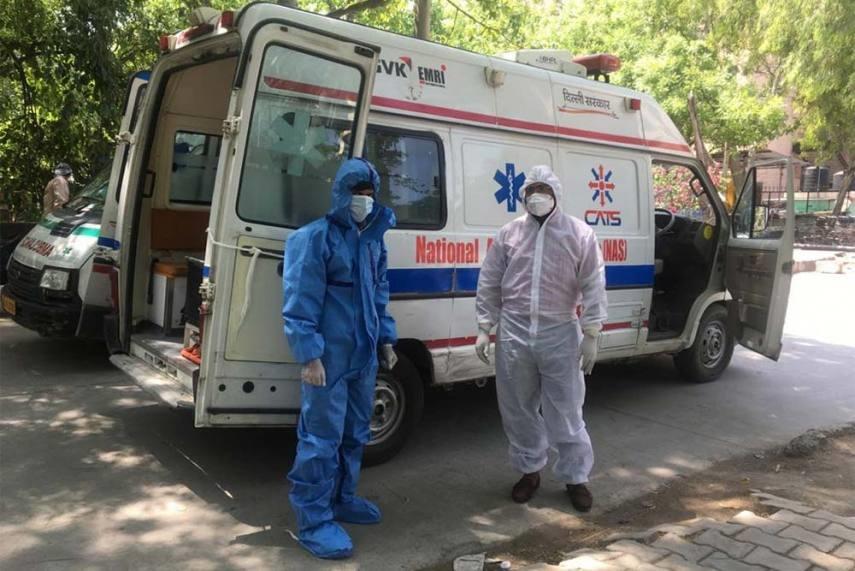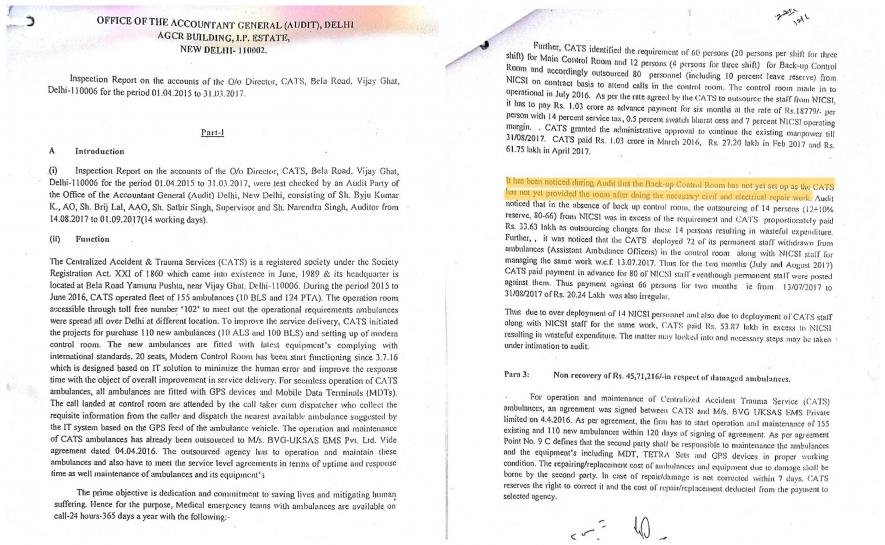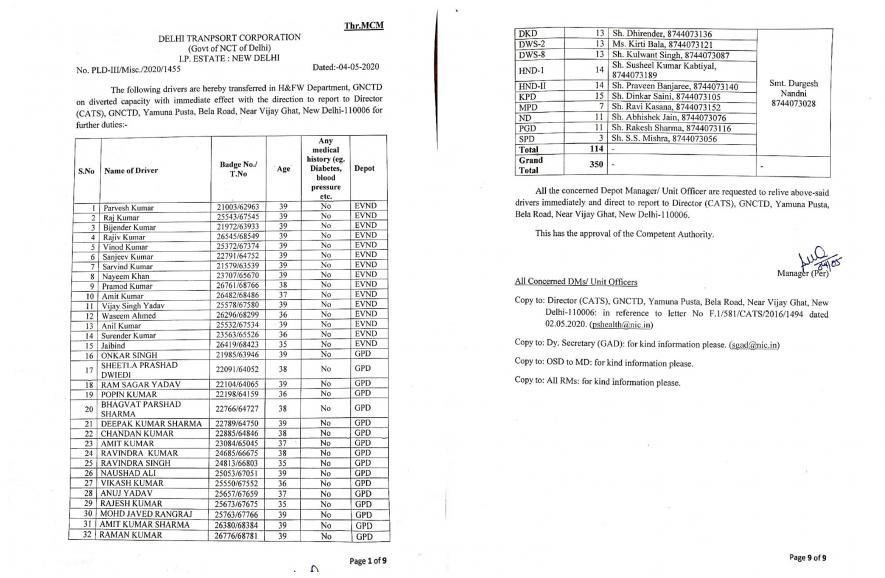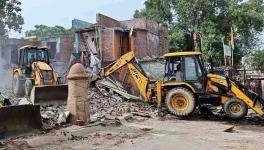COVID-19 Hits Crumbling Ambulance Service; Delhi Govt’s Response Betrays Its Own Service Requirements

As the control room of the ambulance service operating in the national capital emerged as a COVID-19 hotspot, Delhi government’s response to it both, in terms of containing the virus and keeping the ambulances ply on the street, flouted its own service level requirements, show documents, reviewed by NewsClick.
The result: not only the entire workforce – which numbers in hundreds – has been exposed to the deadly novel coronavirus while having to toil for longer hours, grave delinquency on the part of Aam Aadmi Party-led government has also endangered the lives of those who are required to avail the service in times of medical emergency.
On May 10, Chief Minister Arvind Kejriwal, in his press briefing, took note of the shortage of state-run ambulances and the excruciating wait hours; however, he counted on ambulances of private hospitals.
The documents, accessed by NewsClick, reveal a backstory of this crumbling emergency medical service in the national capital and tells how as Delhi struggles to control the pandemic, its difficulties were years in the making, and started with the decision to outsource the operations of ambulance to a private contractor, back in 2016.
On May 8, it was reported that out of 65 employees of the control room of Centralised Accident and Trauma Services (CATS) – the body which provides 24*7 free ambulance services, accessible through toll free number ‘102’ – who were tested, 29 more were found to be positive for COVID-19 disease, taking the total number of infections to 46. The control room is where CATS employees handle calls made to the ‘102’ helpline.
This was, however, 15 days after the first case of infection was reported among the assistant ambulance officers, who handle the call services. Over the period, the control room, situated on the fourth floor of a Delhi government health department office in Laxmi Nagar, continued to operate with routine sanitisation, even though the rule states that it should have been sealed for at least two days.
The control room, which saw work shifts decrease from three to two as a result of a positive case, however, also continued to remain a place where Protective Personal Kits (PPEs) for the ambulance staff were kept. The employees had earlier alleged that the ambulance staffers also used water coolers and toilets – potentially becoming the source of infection in the control room.
The decision to not seal the building by the administration cost the CATS officers heavily, which resulted in jeopardising the lives of their family members as well. As calls kept coming in round the clock, everyday, demanding ambulance service in the wake of the virus outbreak, shutting the operations was not an option available with the administration.
It is pertinent to note that this wouldn’t have been the case had the ‘backup control room’ been set up by the Delhi government, which was proposed way back in 2015 itself. According to a tender document issued by CATS in January 2015 inviting Expression of Interest (EOI) for “short-listing of bidders for Operation and Maintenance of CATS Ambulance Services and Control Room”, upon setting up of a proposed modern control room for the operation of CATS, the the then control room was expected to serve as a backup.
“The Modern Control Room will function as main control room with real time data recovery through cloud technology and in case of its failure, the existing Control Room at Bela road will function as “Backup Control Room” with 4 seats,” the tender document said. The Bela road, near Vijay Ghat in Delhi, is where the CATS headquarter is located.
An audit report of the accounts of CATS in September 2017, accessed by NewsClick, however, revealed that the backup control room was never set up, even though the operations of ambulance services were shifted to modern control room in 2016, location of which was changed to the present location of the CATS control room in Laxmi Nagar.
“It has been noticed during Audit that the Back-up Control Room has not yet set up as the CATS has not yet provided the room after doing the necessary civil and electrical repair work,” said the report prepared by Delhi’s office of the accountant general (audit).

Copy of the audit report which revealed (highlighted) that the backup control room was never set up.
The report added that CATS even paid Rs. 33.63 lakh, termed as “wasteful expenditure”, to a private agency for outsourcing the staff required for the functioning of the backup control room.
Former employees of CATS told NewsClick that the backup control room has still not been set up, which is the main reason why operations at the Laxmi Nagar-situated control room continued, despite recording positive cases.
“Employees have been infected with COVID-19. Despite this, it [control room] has not been sealed because if it was, then the backup control room scam could be exposed. If the backup was set up, employees would not have to put their lives at risk,” said the former employee. Even to this day, the operations from Laxmi Nagar building haven’t been shifted, where at least 39 assistant ambulance officers are working in two shifts.
Calls made to the office of administrative officer, CATS, went answered. Former administrative officer (operation) Laxman Singh Rana, who retired this year in February, was also approached. He declined to comment on the matter.
Transferring Public Transport Workers to Drive Ambulances
Moreover, in an attempt to hide its own shortcomings in setting up a backup to the control room, the Delhi government, on the other hand, passed directions to ensure no labour shortage which could have brought the already deteriorating arrangements of ambulance services in the national capital to a halt, at a time when they are needed the most.
GVK EMRI, the private company which won the contract of operating and maintaining the CATS ambulance service in 2019, saw many of its employees – drivers and paramedics – not reporting for work, starting from the first week of April.
“Around 350 of our workers didn’t come as they were home quarantined or were advised by doctors to isolate themselves,” Pramod Bhatt, Delhi’s Project Manager, GVK EMRI told NewsClick, “another 200 to 150 have not reported to work as they are stuck in other states”.
Confirming the same, Jaswant Lakra, Vice President of CATS Staff Union, however contradicted the line of reasoning. He believed that employees refused to work owing to lack of safety equipment in the ambulances. “These were your front line workers who were supposed to also ferry patients infected with the virus – among others. As per the contract, the responsibility to provide them PPE was on GVK EMRI which had failed to do so, resulting in fear of infection among employees,” he said.
To meet the labour shortage, on May 4, in an order issued by Delhi Transport Corporation (DTC), 350 of the DTC bus drivers were transferred to CATS. “They were transferred to drive the ambulances and fill the positions of those who were not reporting to work,” Lakra informed, which was also confirmed by Bhatt.
“Additional ambulances were acquired from states including Uttar Pradesh and Kerala in recent months,” Bhatt said, adding that there was a need for ambulance staff, even though to manage the manpower is also the responsibility of the bidding company, as per the 2019 tender documents, reviewed by NewsClick. Interestingly, in 2019, the operations of the CATS control room were not outsourced, as opposed to when it was in April 2016.

Copy of the order dated May 4 issued by DTC transferring public transport drivers to CATS.
The move to transfer public transport drivers was aimed at keeping the ambulances running, no matter what. The fact that the DTC drivers were not medically trained to fill the shoes of the staffers in ambulances roused no concern for the Delhi government, even when faced with one of the worst medical emergencies of the decade.
What’s more, in doing so, the government betrayed its own service level requirement. According to the 2019 tender document, under “Qualifications and trainings for Ambulance Manpower”, an ambulance paramedic is required to be holder of either a certificate course in Pre-Hospital Trauma Technician (PTT) or a diploma holder in nursing or pharmacy with registrations in respective state council. A driver is also required to be trained in basic first aid, along with a valid driving license.
“I fear none of the DTC drivers” – now transferred to drive ambulances in Delhi – “are qualified to run ambulances,” Lakhra said. “Ambulances are not public transport. Think about the health dangers it poses to both – workers and patients.”
When asked about the potential risks, Bhatt “understood” the question; however, declined to comment. “This is the government's decision, not ours. Ask them, they [Delhi government] only can give answers, he told NewsClick.
Richa Chintan of Delhi chapter of Jan Swasthya Abhiyan, a national platform that coordinates activities on health care, terms the move “bizarre”. According to her, there is a “terrible lack of ambulance service” in the national capital and such “ad-hoc” measures will only make treatment worse in times of COVID-19.
The ambulance staff “needs to know the [medical] protocol,” she said, “the ambulances should have been revamped and geared up,” especially as restrictions on private vehicles are in place due to virus-induced lockdown.
The decision, while raising deep concerns over Delhi government’s medical laxity, has also drawn flak from the union of CATS staff, many of whom are forced to sit at home owing to a labour unrest earlier in 2019.
In 2019, when GVK EMRI was awarded the contract, all the jobs under CATS were outsourced to this private company. The contract employees, whose employer was Delhi government, protested against the decision and staged a strike that lasted for 76 days.
“A private company always cheats – either with worker’s rights or salaries. Delhi’s ambulance services were better when it was not outsourced. Now, neither the public is happy nor the workers,” Narendra Lakra, President of CATS Staff Union told NewsClick while referring to April 2016 when it was first outsourced to a private company named BVG-UKSAS EMS Private Limited.
Both, Narendra and Jaswant, are among a batch of workers who were not called for work to drive ambulances, despite years of experience, by the Delhi government even when faced with a pandemic. “Around 400 of the ambulance staff members have been sitting at home since June last year. Despite Delhi government’s assurances, we have not been called back to work,” Narendra said.
A detailed questionnaire has been sent through email to CATS Project Director, Chief Secretary of Delhi government and Secretary at Delhi government’s Department of Health and Family Welfare. All three, along with Delhi’s health minister, form the executive body of CATS. The copy will be updated if and when their comments are received.
Update: On May 12, four more assistant ambulance officers working in the CATS control room tested positive for the novel coronavirus, reported Dainik Bhaskar.
The report also added that a decision to shift the operations of control room has been taken by the Delhi government on Monday. However, when checked at 11.30 in the morning of May 12, an official order in this regard was yet to be uploaded on Delhi government's portal.
Also read: UP: Woman Dies after Multiple Hospitals in Meerut Refuse Treatment Fearing COVID-19 Infection
Get the latest reports & analysis with people's perspective on Protests, movements & deep analytical videos, discussions of the current affairs in your Telegram app. Subscribe to NewsClick's Telegram channel & get Real-Time updates on stories, as they get published on our website.
























